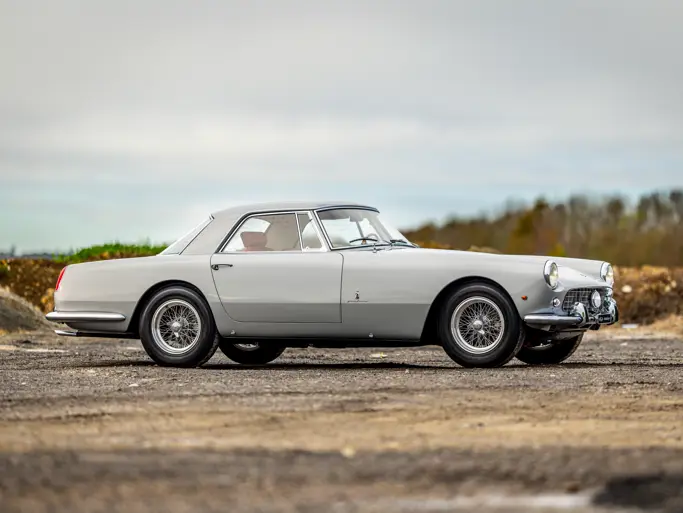240 bhp, 2,953 cc single overhead-camshaft V-12 engine with triple Weber carburettors, four-speed manual gearbox with overdrive, front double-wishbone suspension and rear semi-elliptic leaf springs, and front and rear disc brakes. Wheelbase: 2,600 mm
Tifosi and other race fans alike got their first look at Ferrari’s newest addition to the 250 series of cars at the 1960 24 Hours of Le Mans. Surprisingly, this new car was not on the race track battling it out with the likes of Aston Martin’s and Jaguar’s newest sports racers; it was being piloted by the course marshal instead. Keen eyes were quick to notice that this car had not two seats but four. Ferrari had produced several special-order 2+2s in conjunction with Ghia, Touring, and Vignale for demanding clients in the past, but this would be the marque’s first car of its type ever produced by the company.
Just six months after the 24 Hours of Le Mans, at the 1960 Paris Salon, Ferrari formally introduced the course marshal’s car to the public. As the 250 GTE was the first four-seater ever to be “mass-produced” by the company, it represented Ferrari’s ever increasing attention to their road car division. However, the company would certainly not turn its attention away from motorsport, nor would it leave development and engineering from motorsport out of its road cars. As the 250 GTE shared the same wheelbase as the legendary 250 GT LWB Tour de France and was equipped with a similar Colombo V-12, it was capable of a top speed of just over 150 mph, proving to more traditional Ferrari clients that performance would never be compromised in a car from Maranello.
Those familiar with V-12 Ferraris of this era will notice that the 250 GTE stands slightly wider than its siblings. In order to make the car comfortable for four people, Ferrari’s engineers had to make several changes to the existing 250 platform, which included moving the car’s engine forward on the chassis and widening the track of all four wheels. This made the 250 GTE much more comfortable for those sitting in the back, as well as for those sitting in the front seat. With coachwork designed by Pininfarina, the 250 GTE’s design was not only that of stately elegance, but it was also easily recognisable as a Ferrari, making it a sporting automobile in every sense of the word.
All these changes undoubtedly lead to the 250 GTE’s success as Ferrari’s best-selling model ever at the time, helping to put the brand in the public spotlight and put Ferraris in the garages of well-heeled individuals who might not have otherwise bought a more competition-focused automobile. Over its four years of production and three slightly different model variants, Ferrari produced 954 examples.
This first series 250 GTE, bearing chassis number 2877 GT, was the 230th Ferrari 250 GTE built, according to noted Ferrari historian Marcel Massini. It was completed by the factory on 25 September 1961, and it was originally finished in Bianco over Nero. In October 1961, it was delivered to official Ferrari dealer Italauto SA in Lausanne, Switzerland. That same month, it was sold to its first private owner, a Mr Stagni, of Lausanne. It is believed that Stangi kept the car for the next 13 years and then sold it to Robert Berliat, of Bern-Köniz, Switzerland, in April 1974. A few years later, the car was sold once more, to Eduard Bürki, but it was now finished in dark red. The car passed through a few more owners in Switzerland, and it remains in that country to this day. The car was refinished in a lighter shade of red over a decade ago, and it still presents very well overall.
In terms of the rest of the 250 family of Ferraris, the GTE represents remarkable value, and as the 250 GTE boasts the same 3.0-litre Colombo V-12 that found its way into some of the most valuable cars to ever wear the Prancing Horse, it is still a Ferrari through and through. Whilst it holds no racing pedigree, the 250 GTE proved to be a commercial success for Ferrari, as well as a wonderful car that was capable of both high-performance driving and luxurious touring. For the individual looking to enjoy a classically beautiful Ferrari with more than one passenger, there is truly nothing better.

 | London, United Kingdom
| London, United Kingdom


